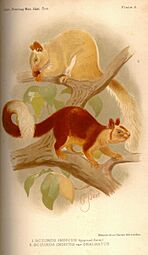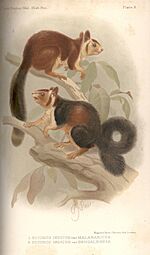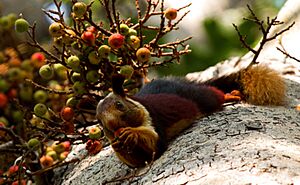Indian giant squirrel facts for kids
Quick facts for kids Indian giant squirrel |
|
|---|---|
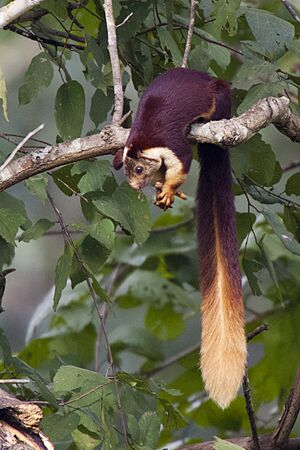 |
|
| R. i. indica in Bhadra Wildlife Sanctuary, Karnataka, India | |
| Conservation status | |
| Scientific classification | |
| Genus: |
Ratufa
|
| Species: |
indica
|
| Subspecies | |
|
|
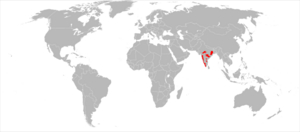 |
|
| Indian giant squirrel range | |
The Indian giant squirrel, also called the Malabar giant squirrel, is a very large and colourful tree squirrel. Its scientific name is Ratufa indica. These amazing squirrels live only in the forests and woodlands of India. They are active during the day (this is called diurnal), live mostly in trees (this is called arboreal), and mainly eat plants (this is called herbivorous).
Contents
Where the Indian Giant Squirrel Lives
This special squirrel is found only in India. It lives in the Western Ghats, Eastern Ghats, and Satpura Range. You can find them as far north as Madhya Pradesh. They live in tropical forests, including deciduous (trees that lose leaves) and evergreen (trees that keep leaves) areas. They can be found from about 180 meters to 2,300 meters high.
Indian giant squirrels need healthy forests to live. They do not do well if their home is damaged or broken up. They usually build their nests in tall trees, often around 11 meters high. This helps them stay safe from animals that might try to hunt them.
What the Indian Giant Squirrel Looks Like
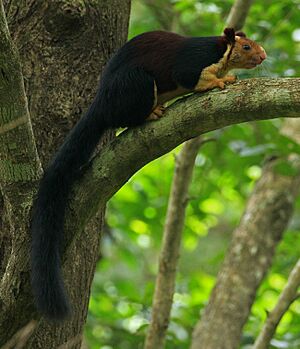
The Indian giant squirrel is one of the biggest squirrels in the world! Its body, from head to tail, can be about 25 to 50 centimeters long. Its tail is usually about the same length or even longer. These squirrels weigh between 1.5 and 2 kilograms, but some can be as heavy as 3 kilograms. On average, they are about 36 centimeters long with a 45-centimeter tail, weighing around 1.7 to 1.8 kilograms.
These squirrels are known for their bright, colourful fur. They can have one, two, or even three different colours on their body. The colours can be white, cream, beige, tan, rust, reddish-maroon, brown, dark brown, or black. Their belly and front legs are usually cream-coloured. They also have a clear white spot between their ears. The rest of their colours depend on which type of Indian giant squirrel they are.
Types of Indian Giant Squirrels
Scientists have described ten different types, or subspecies, of the Indian giant squirrel. However, most experts now recognize four main types:
- R. i. indica: This type lives in the northern and central Western Ghats. Its upper body and the first half of its tail are a rich reddish-maroon or reddish-brown. The end of its tail is whitish or buff.
- R. i. centralis: This type is found in central and eastern India. It is smaller than R. i. indica. It has black fur on its shoulders and a black tail, except for a pale tip.
- R. i. dealbata: This type was found in southern Gujarat. It is a very pale squirrel, mostly creamy-buff with a whitish tail and brown ears. Sadly, recent searches have not found any, so it might be extinct.
- R. i. maxima: This type lives in the southern Western Ghats. It looks like a large R. i. centralis, but has more black on its shoulders and rump. Its tail is almost completely black.
Indian Giant Squirrel Behavior
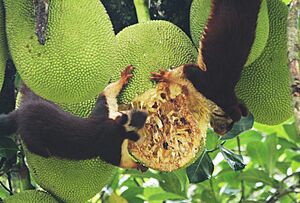
The Indian giant squirrel spends almost all its time high up in the trees. It rarely comes down to the ground. They need tall trees with many branches to build their nests. They can jump up to 6 meters from one tree to another!
When these squirrels feel danger, they often freeze or press themselves flat against a tree trunk. This helps them blend in and avoid being seen. Their main enemies are birds of prey like owls and big cats like the leopard. These squirrels are most active in the early morning and evening, resting during the hottest part of the day. They usually live alone, only coming together to have babies. These squirrels help the forest by spreading seeds from the fruits they eat.
Their diet includes fruits, flowers, nuts, and tree bark. Sometimes, they might also eat insects or bird eggs.
Family Life and Reproduction
Indian giant squirrels live alone or sometimes in pairs. They build large, round nests made of twigs and leaves. They place these nests on thinner branches, where larger predators cannot easily reach them. You can often spot these nests in forests when the leaves fall off the trees in the dry season. One squirrel might build several nests in a small area. They use some for sleeping and one special nest as a nursery for their young.
Studies on a similar squirrel, the Malayan giant squirrel, show that babies are born in March, April, September, and December. At birth, the young weigh about 74.5 grams and are around 27.3 centimeters long. In some parts of India, Indian giant squirrels have been seen with their young in March.
Special Recognition
The Indian giant squirrel is very important in India. It is the official state animal of Maharashtra, a state in western India. In the Marathi language, it is called shekaru.
See also
- Indian giant flying squirrel
- Seshachalam Hills biosphere



